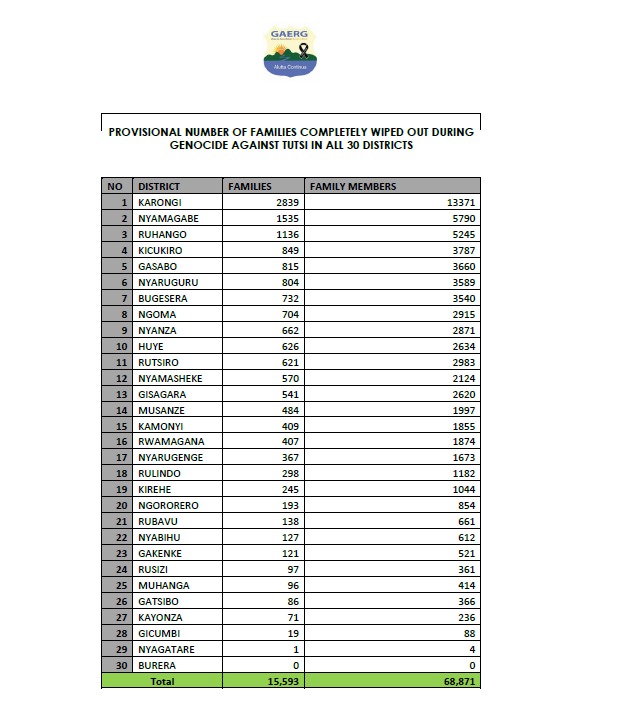
France contingents in Rwanda during the 1994 Genocide against Tutsi
The 1994 Genocide committed against Tutsi in Rwanda was that harsh that it spared none in the family structure; children, adolescents, adults, people with disability and the elderly who would still die a natural death any time during the three months that lasted the tragedy.
While one school of Genocide deniers defends that there was in Rwanda a “double Genocide, another one negates the role of some countries and international players in the tragedy.
However, here comes another fact that shows that, had some foreigners left Rwanda alone, the Genocide austerity would have reduced tremendously.
The Alumni of Genocide Survivors’ Students Association (GAERG) is preparing a documentary which shows that 15,593 families including 68,871 family members were completely wiped out during the Genocide.
Majority of the families were located in the areas where the Rwanda Patriotic Front (RPF) Inkotanyi did not reach during the liberation struggle because there were strongholds of foreign armies in “peacekeeping” mission.
For example, among the 15,593 recorded families, most of them were in Karongi and Nyamagabe districts, a zone commonly known a Zone Turquoise, during genocide.
This zone is where the then genocidal government officials, army and some interahamwe militias were aided by French army to create a safe escape route into the DR Congo after losing to an offensive mounted by RPF soldiers to stop acts of genocide.
In Karongi district, 2839 families including 13371 family members were wiped out, according to GEARG list.
For anyone who read stories of betrayal of the French contingents in Bisesero which is current Karongi district, how they abandoned the Tutsi in the hand of the killers, the area having the biggest number of wiped out families is no surprise.
Number two on the list is obvious Nyamagabe district where Murambi Genocide memorial is located. If you recall, in Murambi, French contingents did it all to show the Tutsi hatred to an extent that they even put a volleyball pitch above mass graves and started playing and enjoying games as if nothing happened.

Statistics-Wiped out families-Source: GAERG
In Nyamagabe, 1535 families including 5790 family members were wiped out.
Ruhango, Kicukiro and Gasabo districts respectively are also on the list of top five and when you watch closely, the hand of a foreigner was involved.One may recall an incident of ETO Kicukiro where Belgium contingents abandoned the Tutsi to Interahamwe militia.
Contrary to Zone Turquoise, other places where the RPF reached and intervened on time show low figures of wiped out families.
For instance, in Nyagatare district there is only one wiped out family recorded, 71 in Kayonza and 86 families in Gatsibo districts in the eastern province where the RPF started the liberation offensive in 1990.
To pay tribute to the 1million lives that were killed in a range of a hundred days, last year, GAERG announced plan to put information about these families in a comprehensive book, film documentary and data base collection
In an exclusive interview with KTPress January 24, Fidele Nsengiyaremye, the GAERG Executive Secretary said that not all the recorded families will appear in the book but a sample of 15 families.
They are included in 15 categories which include teachers, politicians, pastors, media, medical practitioners, farmers, agronomists, sport personalities, to mention but a few.
Nsengiyaremye said that the National Commission for the Fight against Genocide (CNLG) has been very helpful in the process of collecting and recording this information, but there is a funding deficit.
“We have so far raised Rwf4million from our own members, in order to conduct this exercise but we need more funding from well-wishers and organizations in and outside the country,” Nsengiyaremye said.
With the budget, Rwf64million, GAERG plans to spend Rwf34.5million on the publication of a 140 page book and to put Rwf22.2million on the documentary film. Another Rwf7.5million was dedicated to the construction of a database on wiped families.
While the full funding is not yet available GAERG says that it will make calls to the general public to get involved and possibly approach organizations in the country to contribute.

A french soldier during operation Turquoise
Several other ways will also be used to keep memories of the wiped out families
“We will call for action where some partners can for example plant monuments or a tree in places where these families lived,” Nsengiyaremye said.
As this plan gets underway, on Saturday, GAERG started on Saturday January 25, 2020, with documenting one family of Professor Pierre Claver Karenzi, a former lecturer of the University of Rwanda in Butare (now Huye District).
Nsengiyaremye said that the documentary film will be put on the pending list of activities but the book is expected to be published end of June as part of the 26th commemoration of genocide against Tutsi.

